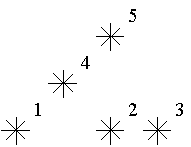Stars
| Time Limit: 1000MS | Memory Limit: 65536K | |
| Total Submissions: 48755 | Accepted: 21068 |
Description
Astronomers often examine star maps where stars are represented by points on a plane and each star has Cartesian coordinates. Let the level of a star be an amount of the stars that are not higher and not to the right of the given star. Astronomers want to know the distribution of the levels of the stars.

For example, look at the map shown on the figure above. Level of the star number 5 is equal to 3 (it's formed by three stars with a numbers 1, 2 and 4). And the levels of the stars numbered by 2 and 4 are 1. At this map there are only one star of the level 0, two stars of the level 1, one star of the level 2, and one star of the level 3.
You are to write a program that will count the amounts of the stars of each level on a given map.

For example, look at the map shown on the figure above. Level of the star number 5 is equal to 3 (it's formed by three stars with a numbers 1, 2 and 4). And the levels of the stars numbered by 2 and 4 are 1. At this map there are only one star of the level 0, two stars of the level 1, one star of the level 2, and one star of the level 3.
You are to write a program that will count the amounts of the stars of each level on a given map.
Input
The first line of the input file contains a number of stars N (1<=N<=15000). The following N lines describe coordinates of stars (two integers X and Y per line separated by a space, 0<=X,Y<=32000). There can be only one star at one point of the plane. Stars are listed in ascending order of Y coordinate. Stars with equal Y coordinates are listed in ascending order of X coordinate.
Output
The output should contain N lines, one number per line. The first line contains amount of stars of the level 0, the second does amount of stars of the level 1 and so on, the last line contains amount of stars of the level N-1.
Sample Input
5 1 1 5 1 7 1 3 3 5 5
Sample Output
1 2 1 1 0
Hint
This problem has huge input data,use scanf() instead of cin to read data to avoid time limit exceed.
Source
题意:给出一些星星的横坐标和纵坐标,而且星星的纵坐标按非递减排列,如果纵坐标相等,则横坐标按递增排列,任意两颗星星不会重合。如果有n颗星星的横坐标比某颗星星小而且纵坐标不大于那颗星星(即有n颗星星位于那颗星星的左下角或者左边)则此星星的等级为n,最后输出等级为0至n-1的星星的数量
思路:
由于y是不下降的,那么对于每个星星来说,计算它的等级只需要用到它前面给出的星星的坐标(后面星星的y值必定大于它)。而求前面星星x值大于该星的数量可用到树状数组,所以开一个数组存储不同等级的数的个数、
代码:
#include<iostream>
#include <stdio.h>
using namespace std;
int x[15010]; //输入数据
int ans[100010]; //树状数组
int cnt[100010]; //存储每个等级的个数
int maxn;
int lowbit(int num)
{
return num&(-num);
}
void add(int num)
{
while(num<=maxn+1)
{
ans[num]++; //相当于树状数组加1
num=num+lowbit(num);
}
}
int cal(int num) //计算小于sum的数的个数
{
int sum=0;
while(num>0)
{
sum=sum+ans[num];
num=num-lowbit(num);
}
return sum;
}
int main()
{
int n,y;
int i;
scanf("%d",&n);
for(i=1;i<=n;i++)
{
scanf("%d%d",&x[i],&y);
if(x[i]>maxn)
maxn=x[i];
}
for(i=1;i<=n;i++)
{
cnt[cal(x[i]+1)]++; //注意此处为了避免是0所以进行加1.0处无意义的
add(x[i]+1);
}
for(i=0;i<n-1;i++)
printf("%d\n",cnt[i]);
printf("%d\n",cnt[n-1]);
return 0;
}








 本文介绍了一种使用树状数组高效统计星图中各星等级数量的方法。通过输入星星的坐标,程序能快速计算出每颗星周围较低等级星星的数量,并统计各等级星星总数。
本文介绍了一种使用树状数组高效统计星图中各星等级数量的方法。通过输入星星的坐标,程序能快速计算出每颗星周围较低等级星星的数量,并统计各等级星星总数。
















 516
516

 被折叠的 条评论
为什么被折叠?
被折叠的 条评论
为什么被折叠?








